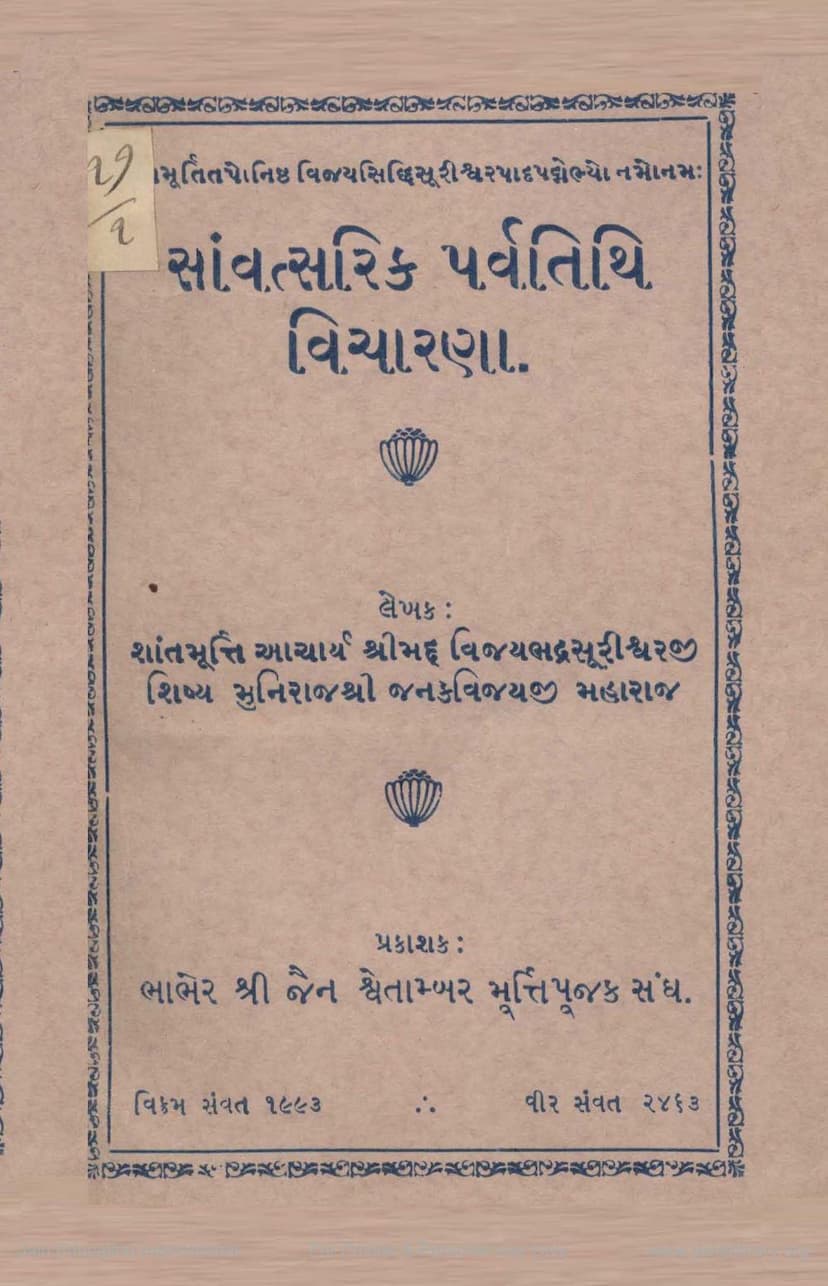Samvatsarik Parvatithi Vicharana
Added to library: September 2, 2025

Summary
Here's a comprehensive summary of the Jain text "Samvatsarik Parvathithi Vicharana" by Muniraj Shri Janakvijayji:
Overall Purpose:
This book is a detailed examination and clarification of the correct dates for Jain religious observances, particularly focusing on the timing of the Paryushana festival and the related Samvatsarik (annual) observance. The author aims to resolve discrepancies and debates within the Jain community regarding these crucial dates, grounding his arguments in scriptural references and historical traditions.
Key Themes and Arguments:
-
The Problem of Tithi (Lunar Day) Calculations:
- The book directly addresses the recurring issue of determining the correct tithi for festivals like Paryushana. The problem arises due to the complexities of the lunar calendar, where tithis can sometimes be truncated (kshaya) or extended (vruddhi).
- The author highlights the societal confusion and debate that arises annually or periodically due to these calculation differences.
-
Importance of Scriptural Authority (Agamas):
- A central tenet of the book is the reliance on the Jain scriptures (Agamas) and the teachings of revered Acharyas and Munis. The author emphasizes that any deviation from scriptural principles leads to confusion and error.
- He cites various scriptures and commentaries, including Suryaprajnaapti, Lokprakash, Jyotishkarn, Sthananga Sutra, and the works of Acharyas like Malayagiri, Vinayavijayji, Ratnashekhar Surishwarji, and Umaswati Vacahakacharya.
-
The Five Types of Samvatsaras (Years) in Jainism:
- The text elaborates on the five types of years mentioned in Jain scriptures:
- Aditya Samvatsara: Related to the sun, characterized by abundance and ripeness of fruits.
- Ritu/Karma Samvatsara: Related to seasons and cyclic processes, often aligned with common usage.
- Chandra Samvatsara: Based on the moon's phases, determining the calculation of tithis.
- Nakshatra Samvatsara: Based on constellations.
- Abhivardhita Samvatsara: A year with an intercalary month, ensuring alignment with the lunar cycle.
- The author explains the calculations and characteristics of each, aiming to show the sophisticated understanding of astronomy and timekeeping within Jain tradition.
- The text elaborates on the five types of years mentioned in Jain scriptures:
-
Analysis of Tithi Rules for Observances:
- Kshaya (Truncation) and Vruddhi (Expansion) of Tithis: The book delves into the specific rules for observing festivals when tithis are truncated or expanded.
- Kshaya: When a tithi is truncated, the observance should generally be performed on the previous tithi.
- Vruddhi: When a tithi is extended (spanning two sunrise periods), the observance should be performed on the second day (the one that properly concludes the tithi, often the one with more of the tithi's duration or the one with two sunrises touching it).
- The Principle of Audayiki Tithi: The core principle for many observances is the "Audayiki Tithi" – the tithi that is present during sunrise. If a tithi is present at sunrise, that is generally the prescribed day for observance.
- Specific Examples: The text meticulously analyzes situations involving the confluence of multiple tithis, the impact of intercalary months, and the rules for determining the correct day for various observances like Ashtami, Chaturdashi, and Purnima.
- Kshaya (Truncation) and Vruddhi (Expansion) of Tithis: The book delves into the specific rules for observing festivals when tithis are truncated or expanded.
-
Paryushana and Samvatsarik:
- The book specifically focuses on the Paryushana festival and the Samvatsarik (annual) observance.
- It argues that based on the scriptural understanding of tithis and the historical practices of revered Acharyas, the Samvatsarik observance should follow specific rules, particularly when there are two Panchami (5th lunar day) tithis in a month.
- The author strongly advocates for performing the Samvatsarik on the fourth tithi (Chaturthi) if the traditional fifth tithi (Panchami) is problematic or if there's a conflict, citing the historical example of Acharya Kalikasuri. This decision was made to ensure the observance occurred without interruption and with proper adherence to the spirit of the festival, even if it meant a slight shift based on specific circumstances and the principle of 'Anagat Chaturthi' (the upcoming fourth day).
- The author refutes the idea of performing the festival on the fifth tithi if it is problematic or if the traditional calendar indicates the fourth. He clarifies that the historical shift to Chaturthi was a calculated decision to maintain the spirit and continuity of the festival.
-
Critique of Misinterpretations and Deviations:
- The author criticizes interpretations and practices that deviate from the scriptural path, often attributing them to a lack of thorough understanding or the influence of popular customs.
- He strongly cautions against adhering to "Utsutra-prapana" (speaking contrary to scriptures) and emphasizes the importance of seeking clarification from knowledgeable ascetics.
-
The Role of Tradition and Lineage (Gachha):
- While respecting the lineage of Acharyas, the author prioritizes scriptural consistency. He notes that different interpretations or practices might arise within various traditions (Gachhas), but the ultimate authority rests with the Agamas.
- He highlights instances where certain Gachhas might have different interpretations but emphasizes the need to return to the foundational scriptural principles.
-
Conclusion and Appeal:
- The book concludes with an earnest appeal to the Jain community to understand and adhere to the scripturally correct methods of calculating festival dates.
- The author expresses a desire for unity and adherence to authentic traditions, encouraging readers to rely on the wisdom of scriptures and enlightened scholars.
- He calls upon contemporary Acharyas and Munis to provide clear guidance to the community to prevent further confusion and ensure correct observance of these sacred periods.
In essence, "Samvatsarik Parvathithi Vicharana" is a scholarly work that meticulously dissects the complexities of Jain calendar calculations, offering scripturally supported solutions for determining festival dates, particularly for the highly significant Samvatsarik and Paryushana festivals. It serves as a guide to uphold the purity of Jain traditions and practices.